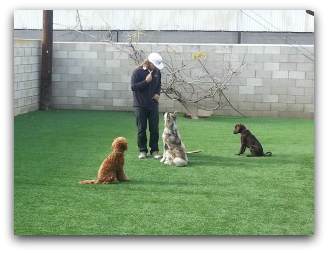
The ideal time to begin training your puppy is the first week you bring him or her home. By training we do not mean formal training or obedience lessons, we mean training your dog to fit in with his or her new pack (YOUR FAMILY) and learning to behave in his or her den (YOUR HOME). Studies on canine development and learning have proven that the most critical learning and socialization periods occur between the ages of eight to sixteen weeks of age.
Click Here For Puppy Training Objectives and Tips
1) To start solving basic behavior problems such as house-soiling, jumping, chewing, and nipping
2) Teaching the proper socialization methods to introduce your new puppy.
3) Techniques to quickly gain your puppies ultimate love and trust.
4) Techniques to start teaching your puppy basic obedience commands so that your dog will love and enjoy to perform them when asked.
5) Setting up multiple compartments where your puppy can spend time unsupervised for short periods of time which are puppy proofed and secure.
In order to have a well rounded non-aggressive, non-phobic puppy you must focus on socialization with your puppy between the ages of eight to sixteen weeks. This is the socialization window. If missed, your puppy has a higher probability of producing undesirable behaviors. The more your puppy is out in the real world, he or she will have a better chance of being comfortable and confident in everyday life situations.
HOW DO I PREVENT MY PUPPY FROM DOING DAMAGE OR GETTING INTO MISCHIEF?
Kind To Canines rule of thumb for puppy training is to set your puppy for success. A puppy should be supervised at all times until he or she has learned what is ok to chew on where they are supposed to go potty. Keeping your puppy on a leash in the house is an excellent way to keep he or she in sight and to teach them not to wonder out of sight when they are young.
WHAT DO I DO IF I CANNOT SUPERVISE MY PUPPY?
Whenever you cannot supervise your puppy for short amounts of time, Compartmentalization is a must. An escape proof crate, play pen, and dog run are all great tools to teach your puppy to be in. When setting your puppy up in different compartments, there are a few factors to consider. The compartments must be very positive. You should give chew toys, food, water, and hands on affection with your puppy in these areas. These compartments should never be an isolated area away from human contact and the human voice.
WHAT IS THE BEST WAY TO PUNISH MY PUPPY
Kind To Canines believes that every effort should be made to avoid punishment for new puppies as it is generally unnecessary and lead to avoidance of certain family members at a time when bonding is most critical. By preventing problems through confinement and supervision, providing for all your puppies needs, and setting up the environment for success, little or no punishment should ever be required. If a reprimand is needed, a verbal “NOPE” followed up by redirection towards a chewy or squeaky toy should divert whatever bad behavior your puppy is doing. Short time outs are also advisable in all your different compartments you have set up. You are to never yell at your puppy while doing a time out. Simply understand your puppy is not being easily distracted with a chewy or squeaky toy to divert a bad behavior so it is time for a short time out with some separation. Your puppy should be in his or her different compartments 4 times to the one time he or she is in for a time out.